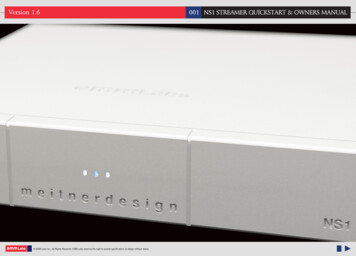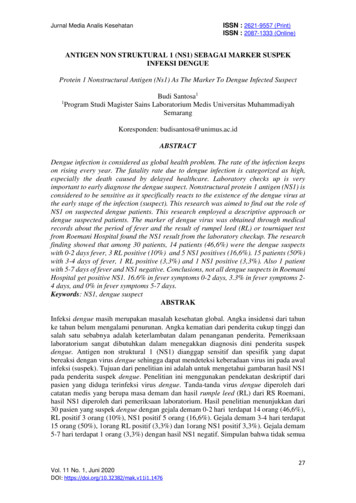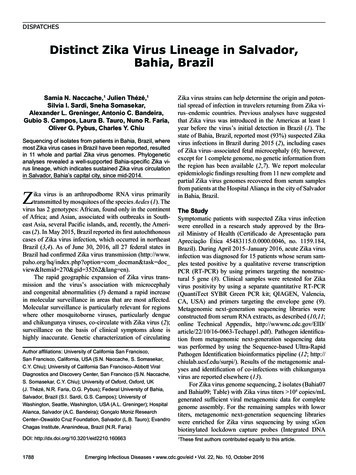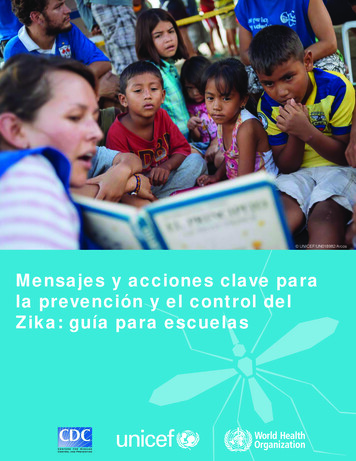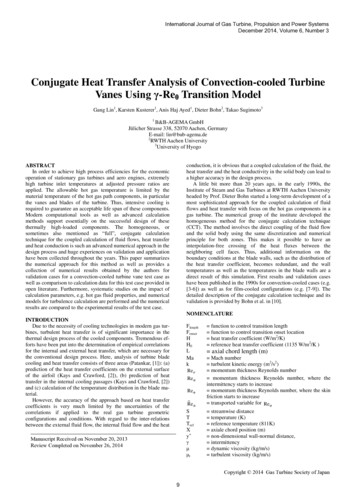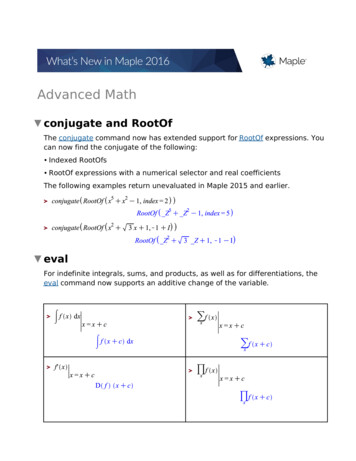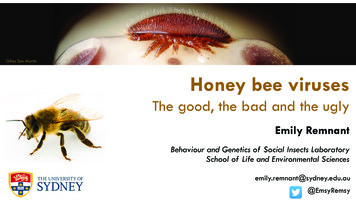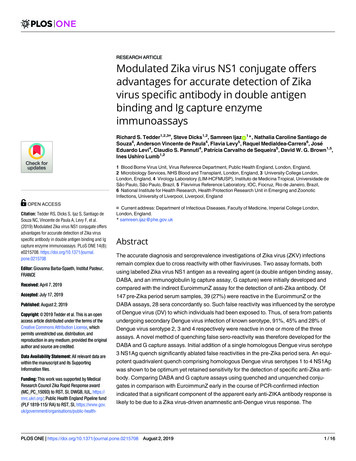
Transcription
RESEARCH ARTICLEModulated Zika virus NS1 conjugate offersadvantages for accurate detection of Zikavirus specific antibody in double antigenbinding and Ig capture 1a1111111111a1111111111OPEN ACCESSCitation: Tedder RS, Dicks S, Ijaz S, Santiago deSouza NC, Vincente de Paula A, Levy F, et al.(2019) Modulated Zika virus NS1 conjugate offersadvantages for accurate detection of Zika virusspecific antibody in double antigen binding and Igcapture enzyme immunoassays. PLoS ONE 14(8):e0215708. : Giovanna Barba-Spaeth, Institut Pasteur,FRANCEReceived: April 7, 2019Accepted: July 17, 2019Published: August 2, 2019Copyright: 2019 Tedder et al. This is an openaccess article distributed under the terms of theCreative Commons Attribution License, whichpermits unrestricted use, distribution, andreproduction in any medium, provided the originalauthor and source are credited.Data Availability Statement: All relevant data arewithin the manuscript and its SupportingInformation files.Funding: This work was supported by MedicalResearch Council Zika Rapid Response award(MC PC 15093) to RST, SI, DWGB, IUL, https://mrc.ukri.org/; Public Health England Pipeline fund(PLF 1819-115/ RA) to RST, SI, -health-Richard S. Tedder1,2,3 , Steve Dicks1,2, Samreen Ijaz ID1*, Nathalia Caroline Santiago deSouza4, Anderson Vincente de Paula4, Flavia Levy5, Raquel Medialdea-Carrera6, JoséEduardo Levi4, Claudio S. Pannuti4, Patrı́cia Carvalho de Sequeira5, David W. G. Brown1,5,Ines Ushiro Lumb1,21 Blood Borne Virus Unit, Virus Reference Department, Public Health England, London, England,2 Microbiology Services, NHS Blood and Transplant, London, England, 3 University College London,London, England, 4 Virology Laboratory (LIM-HCFMUSP), Instituto de Medicina Tropical, Universidade deSão Paulo, São Paulo, Brazil, 5 Flavivirus Reference Laboratory, IOC, Fiocruz, Rio de Janeiro, Brazil,6 National Institute for Health Research, Health Protection Research Unit in Emerging and ZoonoticInfections, University of Liverpool, Liverpool, England Current address: Department of Infectious Diseases, Faculty of Medicine, Imperial College London,London, England.* samreen.ijaz@phe.gov.ukAbstractThe accurate diagnosis and seroprevalence investigations of Zika virus (ZKV) infectionsremain complex due to cross reactivity with other flaviviruses. Two assay formats, bothusing labelled Zika virus NS1 antigen as a revealing agent (a double antigen binding assay,DABA, and an immunoglobulin Ig capture assay, G capture) were initially developed andcompared with the indirect EuroimmunZ assay for the detection of anti-Zika antibody. Of147 pre-Zika period serum samples, 39 (27%) were reactive in the EuroimmunZ or theDABA assays, 28 sera concordantly so. Such false reactivity was influenced by the serotypeof Dengue virus (DV) to which individuals had been exposed to. Thus, of sera from patientsundergoing secondary Dengue virus infection of known serotype, 91%, 45% and 28% ofDengue virus serotype 2, 3 and 4 respectively were reactive in one or more of the threeassays. A novel method of quenching false sero-reactivity was therefore developed for theDABA and G capture assays. Initial addition of a single homologous Dengue virus serotype3 NS1Ag quench significantly ablated false reactivities in the pre-Zika period sera. An equipotent quadrivalent quench comprising homologous Dengue virus serotypes 1 to 4 NS1Agwas shown to be optimum yet retained sensitivity for the detection of specific anti-Zika antibody. Comparing DABA and G capture assays using quenched and unquenched conjugates in comparison with EuroimmunZ early in the course of PCR-confirmed infectionindicated that a significant component of the apparent early anti-ZIKA antibody response islikely to be due to a Zika virus-driven anamnestic anti-Dengue virus response. ThePLOS ONE https://doi.org/10.1371/journal.pone.0215708 August 2, 20191 / 16
Modulated Zika virus NS1 conjugate for accurate detection of Zika virus specific antibodyengland. The funders had no role in study design,data collection and analysis, decision to publish, orpreparation of the manuscript.increased specificity provided by homologous antigen quenching is likely to provide a significant improvement in sero-diagnostics and to be of clinical value.Competing interests: The authors have declaredthat no competing interests exist.IntroductionZika virus (ZKV), first described in a nonhuman primate in 1947, is named after a forestedarea in Uganda [1]. Its ability to infect humans was first demonstrated in 1952 as reviewed byKindhauser and colleagues [2] with antibody to ZKV detected both by neutralisation and byanimal protection experiments [3]. Zika virus is one of a number of closely related Flaviviruses,previously termed Arboviruses, principally transmitted through the bite of an infected Aedesmosquito, most commonly Aedes aegypti but which may also be transmitted directly betweenhumans through sexual contact or vertically, from mother to the unborn baby. Although possible, no cases of transmission through transplantation of cells, tissues or organs have beenreported to date; probable transmission through blood products have been reported [4–6].Similar to other related flaviruses, ZKV infection is believed to be asymptomatic in up to 80% ofcases, with a minority manifesting often mild symptomatology [7]. The clinical illness is of shortduration and detectable viraemia seldom exceeds seven days from the illness onset [8]. The infection may persist for longer in a number of sanctuary sites [9] including the male genital tract [4,10].It is likely that ZKV may have caused outbreaks of disease but that these may well have beenunrecognised because the clinical illness is similar to that caused by other known pathogensincluding Dengue (DV) and Chikungunya viruses. Where ZKV differs is that its neuro-tropismand ability to infect the unborn child transplacentally leads to serious neurological birth defects[11]. The significant morbidity caused by Congenital Zika Syndrome, the societal impact and costsof this in both Polynesia and more recently in countries in South and Central America have addedto the requirement for both sensitive and specific tests for the detection of antibody to ZKV (antiZKV). However, extensive serological cross-reactivity between flaviviruses and their co-circulationhas rendered this difficult to achieve using the conventional indirect immunoassay format.In collaboration with Corti and his colleagues we previously investigated a novel competitive immunoassay for the detection of anti-ZKV [12]. Whilst it conferred considerablyimproved accuracy in relation to the limited assay options available, we have further investigated two other test formats for the detection of anti-ZKV including reverse capture (G capture) and double antigen binding assay (DABA) principles. Both use a common revealingconjugate of enzyme labelled ZKV NS1 antigen, which together with the addition of unlabelled competitor homologue DV NS1 proteins provides a unique and novel approach to thespecific quenching of false reactions due principally to coexisting antibody to other related flaviviruses. Here we describe the performance of these assays and the novel approach to quenching non-specific reactivity in the face of antibody to Dengue viruses as this was the closelyrelated flavivirus of most relevance in the South American cohorts used in this study, nevertheless recognising that in a global context, other related viruses may induce false serological reactivity. We compared the performance of these two assays with the widely used EuroimmuneZKV antibody Elisa (EuroimmunZ) for the detection of antibody to ZKV in the presence ofantibody to Dengue virus (anti-DV) of various serotypes.Materials and methodsPatient samplesOverall, 422 samples were available for analysis (Table 1)PLOS ONE https://doi.org/10.1371/journal.pone.0215708 August 2, 20192 / 16
Modulated Zika virus NS1 conjugate for accurate detection of Zika virus specific antibodyTable 1. Sample and donor characteristics.Sample characteristicYearPre-ZIKA (N 147)20132014Pre 2014Dengue Virus (n 134)ZIKA Virus (n-138)Post 2014SourcePCR Δ29SPN/ABlood donors118RdeJN/AHepatology Outpatients28SPDV1Acute Dengue Fever r characteristicAcute ZIKA Fever caseTable listing sample used in the analysis. PCR Δ diagnostic PCR where available; N/A: PCR not available. SP: Sao Paolo; RdeJ: Rio de Janeiro. NHSBT: UK NationalHealth Blood Transfusion Service. DV1- DV4; serotype specificity of the diagnostic 001Known Dengue types seropositive samples. Sera were available in São Paulo from 134patients previously infected with DV of PCR confirmed serotype; most samples were takenbefore 2014, when ZKV is believed to have been introduced into the Americas, including 28patients with Dengue virus serotype 1 (DV1) primary infection sampled in 2015; 32 patientswith Dengue virus serotype 2 (DV2) secondary infection sampled in 2010; 34 patients withDengue virus serotype 3 (DV3) proven or presumed secondary infection sampled in 2002 and2005; 40 patients with proven or presumed Dengue virus serotype 4 (DV4) secondary infectionsampled in 2013. The DV serotype of the initial infection is not known but will be a reflectionof the viruses circulating in the community at the time.Pre-Zika period samples. One hundred and forty-seven sera drawn prior to the recognized introduction of ZKV into Brazil were available for testing. One hundred and eighteenwere available in Rio de Janeiro from outpatient clinic attenders at Fiocruz during 2014 (outpatient panel) and 29 samples were available in São Paulo from blood donors taken in 2013; 23of these samples were positive for DV IgG.Zika samples. One hundred and thirty eight sera taken from patients between 1 dayand 1 year after the onset of arboviral-like symptoms of PCR-confirmed Zika infection (95from São Paulo and 31 from Rio de Janeiro, 12 from UK returnees sampled by the Englishblood transfusion service, NHSBT) were available for testing.Ethics. In Rio, the procedures applied in this study were performed in accordance withthe ethical standards of the Instituto Nacional de Infectologia Evandro Chagas. The study protocol was approved by its Comitê de Ética em Pesquisa (reference CAAE 0026.0.009.000–07).In São Paulo, procedures conformed with terms agreed by the Institutional Review Boardfrom Hospital das Clı́nicas, University of São Paulo (CAPPesq- Research Projects Ethics Committee). Specimens were anonymised to ensure patient confidentiality.Flavivirus antigensRecombinant ZKV NS1 (rZKVNS1Ag) antigen expressed by baculovirus in insect cells(MyBioSource Inc, San Diego, USA) was used both to coat the solid-phase where appropriateand, when directly conjugated with horseradish peroxidase, to provide a revealing agent forcaptured antibodies.Recombinant DV NS1 antigens (rDVNS1Ag) from the four serotypes (DV 1–4 inclusive)expressed in mammalian cells (The Native Antigen Company, Kidlington, Oxfordshire, OX51LH, UK) were used in molar excess as components of the conjugate diluent. The addition ofthese un-labelled antigens served to quench reactivity to epitopes on Dengue related antigens.PLOS ONE https://doi.org/10.1371/journal.pone.0215708 August 2, 20193 / 16
Modulated Zika virus NS1 conjugate for accurate detection of Zika virus specific antibodyAssay formatsIndirect immunoassay. The EuroimmunZ kit for the detection of G anti-ZKV antibody(EUROIMMUN AG, Luebeck, Germany) was used in accordance with the manufacturer’sinstructions and defined kit cut-off.G capture assay (G capture). Solid-phase wells (NUNC Immunomodule, U8 Maxisorpwells) were coated with 100μl volumes of Affinipure rabbit anti-human γ (Jackson ImmunoResearch, Ely, Cambridgeshire UK) at 5μg/ml in MicroImmune Coating Buffer for ELISA withpreservative; (ClinTech, Guildford, UK). Coating was overnight at 2–8 C, followed by 3 hoursat 35–37 C. Wells were then washed with PBS Tween 20 and quenched with MicroImmuneBlocking Solution (ClinTech, Guildford, UK) for 3–4 hours at 37 C. Wells were aspirated andstored dry at 4 C in sealed pouches with desiccant until use. Prior to testing, serum sampleswere diluted to 1 in 200 in Transport Medium (TM: Phosphate buffered saline supplementedwith Amphotericin B 0.5ug/ml, Gentamicin 0.25mg/ml, 10% v/v heat inactivated fetal calfserum, Tween 20 0.05% v/v, Red Dye 0.05% v/v). One hundred microlitres of diluted serumwere added to the wells, incubated for 60 2 minutes at 37 C prior to washing and the additionof the conjugate. After a further incubation for 30 2 minutes at 37 C the solid-phase wasagain washed and 100 μl of substrate added, incubated for 30 2 minutes at 37 C, the reactionthen stopped and measured at 450/630nm. Full details are provided as information for use(IFU) leaflets in supplementary information.Double antigen binding assay (DABA). Solid-phase wells (NUNC Immunomodule, U8Maxisorp wells) were coated with 100μl volumes of rZKVNS1Ag at 2μg/ml in MicroImmuneCoating Buffer, overnight at 2–8 C, followed by 3 hours at 35–37 C. Wells were then washedwith PBS Tween 20 and quenched with MicroImmune Blocking Solution for 3–4 hours at37 C. Wells were aspirated and stored dry at 4 C in sealed pouches with desiccant until use.Prior to testing 70 μl of sample diluent (MicroImmune Sample Diluent; ClinTech, Guildford,UK) were added to each well. Thirty microlitres of control or test sera were added singly toeach well and incubated for 60 2 minutes at 37 C prior to washing and addition of conjugate.After a further incubation for 120 5 minutes at 37 C the solid phase was again washed and100 μl of substrate added, incubated for 30 2 minutes at 37 C, the reaction then stopped andmeasured at 450/630nm. Full details are provided as information for use (IFU) leaflets in supplementary information.Data from three-way comparisons between EuroimmunZ, the G capture and the DABAdata generated by individual sera are displayed as Venn diagrams. Two way comparisons aredisplayed as X by Y plots. Exploration of the efficacy of conjugate performance is also displayed as X by Y plots, comparing conjugate with (Quenched) and without (Unquenched) theaddition of DV NS1 antigens to the conjugate diluent.Conjugation of rZKVNS1AgOne hundred microlitres of recombinant ZIKV NS1 antigen (ensuring at an optimal proteinconcentration range of 0.5–5.0mg/ml) were coupled to 100μg of lyophilized HRPO mix usingthe LYNX Rapid HRP Conjugation kit (Bio-Rad Laboratories Ltd, Watford, UK) in accordance with the manufacturer’s instructions Once conjugated the product was diluted 1 in 10in HRP Stabilising Buffer (ClinTech, Guildford, UK) and stored un-fractionated in 50μl volumes at -20 C.Conjugates for capture and DABAHRPO-conjugated rZKVNS1Ag was appropriately diluted in conjugate diluent (Initially product kit GE 34/36, (gifted by DiaSorin UK, Dartford, Kent, UK) and then subsequently ClintechPLOS ONE https://doi.org/10.1371/journal.pone.0215708 August 2, 20194 / 16
Modulated Zika virus NS1 conjugate for accurate detection of Zika virus specific antibodyFig 1. Illustration detailing the immunoglobulin G capture assay (G capture) and the double antigen binding assay (DABA). The G Capture solid phase (crosshatched) is coated with rabbit anti-human gamma FC to capture G from the clinical sample in the first step of the assay. After washing, conjugate is applied and specificantibody (Y) revealed by ZIKA virus NS1 antigen (ZKVNS1Ag) labelled with horseradish peroxidase (HRPO; Z , standard). The DABA solid-phase is coated withZKVNS1Ag to capture antibody to NS1Ag of any class. After washing, conjugate is applied and bound antibody (Y) revealed by ZKV NS1Ag labelled with HRPO 08.g001Conjugate diluent, (ClinTech, Guildford, UK) and either used as such (unquenched) or dilutedin the same conjugate diluent to which had been added a molar excess of rDVNS1Ag ofdefined serotype (quenched). The performance of the conjugate either quenched orunquenched was compared across the range of dengue sero-positive samples and sampleslikely to contain anti-ZKV from patients with confirmed ZKV infection.A schematic illustrating the DABA and G Capture assay formats and the various conjugateoptions is shown in Fig 1.Several options for additions to the conjugate to quench non-specific reactivity have beeninvestigated. The conjugate diluent has been used with (i) no additional unlabelled viral addedantigen (Standard); (ii) with added unlabelled Dengue virus 3 NS1 antigen alone (D, DV 3Quench); (iii) with added unlabelled equi-potent mix of four Dengue virus 1 to 4 NS1 antigens(Q, Quad Quench); and (iv) with added unlabelled ZKV NS1Ag (Z, ZIKA Quench) asdescribed in text.Serological controls for capture and DABAHuman G1 anti-ZKV virus NS1 supplied by the Native Antigen company (Kidlington, Oxford,UK) was used as a positive control. Used at 10ug/ml in G capture assay as the positive qualityPLOS ONE https://doi.org/10.1371/journal.pone.0215708 August 2, 20195 / 16
Modulated Zika virus NS1 conjugate for accurate detection of Zika virus specific antibodycontrol it was required to give an optical density (OD) between 0.8 and 1.5. Used at 2ug/ml inthe DABA assay it was required to give an OD between 2.5 and 3.5.Pooled normal UK human plasma (NHP) previously screened for blood borne viruses constituted the unreactive control. Test samples reacting greater than the mean negative control 0.1 OD where considered to be reactive for anti-ZKV.Detection of Dengue antibodySamples from UK returning travellers were tested for Dengue antibody using the PanBio Dengue IgG Indirect ELISA (Alere/Abbott Diagnostics, Abingdon, UK).ResultsDemonstration of cross-reactivityThe antibody reactivity of 147 samples (118 samples from the 2014 outpatient panel and 29blood donor samples from 2013) archived before the recognised introduction of ZKV intoBrazil was determined in the EuroimmunZ indirect Elisa and in the unquenched DABA (Fig2). Thirty five samples (24%) were reactive on the EuroimmunZ whilst 32 samples (22%) werereactive on the unquenched DABA, 28 (19%) were concordantly reactive in both assays.Fig 2. EuroimmunZ vs Unquenched DABA reactivity in pre-Zika era panels. Plot of sample to cut off (S/CO) ratiosof 147 pre-Zika era samples tested in un-quenched DABA and EuroimmunZ. Fourteen samples with EuroimmunZratios 1.1 were considered indeterminate by EuroimmunZ criteria. Three samples were reactive by DABA alone.Solid lines represent the cut off value for each assay. Trend line is 5708.g002PLOS ONE https://doi.org/10.1371/journal.pone.0215708 August 2, 20196 / 16
Modulated Zika virus NS1 conjugate for accurate detection of Zika virus specific antibodyFourteen of the 147 (10%) were reactive in the indeterminate zone in EuroimmunZ, one ofwhich was reactive in the unquenched DABA. Ninety eight samples (67%) were un-reactive inthe EuroimmunZ, three were reactive in the unquenched DABA.The reactivity given by sera containing anti-DV antibody following known infection byDengue serotypes 1 through 4 was determined in each of the three assays, EuroimmunZ,DABA and G capture, both using un-quenched conjugates. The proportion of samples reactivefor anti-ZKV in one or more assays ranged from 29 of 32 (91%) of samples from patients withsecondary DV2 infections, 9 of 20 (45%) of samples from patients with secondary DV3 to 11of 40 (28%) of samples from patients undergoing secondary DV4 samples. Seven of 28 (25%)samples from patients with primary DV1 reacted in one or more assays (data not shown).Sensitivity of different assay formats for detecting a ZKV serologicalresponseThe evolution of detectability of antibody to ZKV in EuroimmunZ, in DABA and in G captureusing unquenched conjugates, was investigated using a panel of samples from 56 patientsundergoing a confirmed acute ZKV infection. Ninety one sera were tested, 69 were reactive inEuroimmunZ, 78 were reactive in DABA and 60 in G capture (Fig 3). The majority of the samples (52/91, 57%) were concordantly reactive in all three assays. Ranking the samples by timeafter the onset of symptoms indicated that of the 21 samples that were taken in the first weekof symptoms, seven were reactive in EuroimmunZ, 11 were reactive in DABA and ten in Gcapture. Of the 49 samples taken between two and four weeks after the onset of symptoms, allbut one were reactive in both EuroimmunZ and DABA, only 38 were reactive in G capture. Ofthe 20 samples taken more than one year after the acute illness only 15 were reactive in anyassay, ten in EuroimmunZ, 14 in the DABA and eight in the G capture.Conjugate quenching to reduce cross-reactivityThe addition of quenching amounts of unlabelled recombinant DV NS1 antigen of a singleserotype was initially investigated to reduce the signal of apparent Dengue serum antibodyreactivity in the two assays, G capture and DABA, both using HRPO-conjugated rZKVNS1Agas a detector. A panel comprising 32 DV antibody-containing sera samples including thosethat were previously falsely reactive in the unquenched ZKV G capture and/or DABA assayswas selected. The panel was then retested in both assays using a modified conjugate diluentcontaining unlabelled rDV3NS1Ag at a concentration of 25μg/ml. A single serum remainedreactive in the DABA, all other samples the presumed non-specific reactivities were quenchedby the use of conjugate diluent containing rDV3NS1Ag (data not shown).Sensitivity, specificity and optimisation of quenched conjugates fordetecting anti-ZKVA subset of the panel of 95 sera from ZKV patients were re-tested initially using therDV3NS1Ag as the sole constituent of a quenched buffer. In the majority of samples, the levelof anti-ZKV reactivity was not reduced in both G capture and DABA with by the addition ofDV1 antigen to the conjugates. It is noticeable however that a proportion of samples (six from59 in DABA and eight from 41 in G capture) showed significant reduction of reactivity withthe quenched conjugate (these are circled, Fig 4A and 4B respectively).To investigate in more detail the serotype specificity of the quenching effect of rDVNS1proteins, a panel of 20 sera previously displaying strong reactivity in the unquenched G capture assay was run a second time in the G capture and the DABA assay with two differentPLOS ONE https://doi.org/10.1371/journal.pone.0215708 August 2, 20197 / 16
Modulated Zika virus NS1 conjugate for accurate detection of Zika virus specific antibodyFig 3. Antibody reactivity across three assays in samples from PCR confirmed Zika cases. Venn plots for 91 samples from patients with PCR confirmed ZKVinfection. Samples giving sample to cut off ratios 1.0 were defined as reactive. The right hand plot shows reactivity for the panel of 91 samples tested in the threedifferent assays. The three panels on the left in vertical order show the reactivity broken down into the first week, second to fourth week and one or more year after onsetof symptoms. The individual reactivity of samples in each test is shown and the overall reactivity for each assay 5708.g003conjugate diluents. A normal conjugate diluent was used for the unquenched version as referent in comparison with the quenched version of the assay using conjugates containing quenching amounts of rDVNS1Ag, present as rNS1Ag of each DV serotype individually. The degreeof residual activity displayed by the different quenching rDVNS1Ags was greatly influencedby the rDVNS1Ag serotype (Table 2). We also investigated quenching as a quadrivalent equipotent rNS1Ag-blend of all 4 serotypes at concentrations from 25, 12.5 to 6.25μg/ml. Thequadrivalent mix ablated DV-related cross reactivity in the DABA, two samples remained consistently reactive in the G capture assay. Specific anti-ZKV control reactivity remained detectable under all quenching mixtures (Table 3). There was some evidence for a titration of thequenching function over the range from 25 to 6.25μg/ml of competitor DVNS1 homologue inthe G capture conjugate, with mean quenched sample reactivity ranging from 0.63 through0.74 to 0.87 across the two fold titration of quenching NS1 antigen. A similar trend is seen forDABA with mean reactivities of 0.56, 0.61 and 0.63. A single stochastic low level reaction wasPLOS ONE https://doi.org/10.1371/journal.pone.0215708 August 2, 20198 / 16
Modulated Zika virus NS1 conjugate for accurate detection of Zika virus specific antibodyFig 4. 4A and 4B. G capture and DABA data on Zika confirmed panels comparing DV3NS1Ag quenched and un-quenched conjugates. X by Y plots of samplereactivity from patients known to have been infected with ZKV. Reactivity is expressed as sample to cut off ratios when tested using un-quenched conjugate andrDV3NS1Ag-quenched conjugate. Left hand panel (A) displays the results with 59 ZKV convalescent sera (São Paulo and Rio de Janeiro) tested in the DABA usingeither unquenched or quenched conjugates. Dotted line is a line of interpolated equivalence assuming no difference in reactivity. Solid lines represent the assay cut offvalues. Right hand panel (B) similarly displays the reactivity of 41 samples from patients with confirmed ZKV infection tested in the G capture using unquenched andquenched conjugate diluents. Samples from patients with proven ZKV showing a reduced reactivity resulting from the quenched conjugate are circled in both 8.g004seen in the 6.25μg/ml quench DABA assay but the sample was not retested. Based on the relative effectiveness at 6.25μg/ml, this homologue antigen quench concentration was adopted forfurther studies.To explore further the quenching effect of using conjugate quenched with the optimisedquadrivalent mixture of rDVNS1Ag, 87 samples from the 2014 outpatient cohort were retestedusing quadrivalent quenched conjugate at 6.25ug/ml. Twenty three samples reactive in theunquenched DABA and 27 reactive in EuroimmunZ were all unreactive in the quadrivalentquenched DABA (Fig 5A and 5B). Nine samples giving indeterminate reactivity on the EuroimmunZ were unreactive in the quadrivalent quenched DABA. A further 19 anti-DV reactivesamples were subsequently included to give a panel total of 106 samples which were all unreactive in the DABA indicating a high specificity.A further panel of 38 samples from 19 ZKV-infected patients taken at various times afterthe onset of disease was again re-tested in the G capture assay only (to conserve sample volumes) using the optimised quadrivalent quench and the resulting reactivity compared with thereactivity in the EuroimmunZ assay. This demonstrated a considerable divergence betweenreactivity in the two assays, most prominently observed early in the illness time course withthe anti-ZKV reactivity in the GG capture assay with a quenched conjugate often found to bevery much reduced, particularly in the first week after diagnosis (Fig 6).To investigate the specific reactivity of sera from patients not domiciled in a Dengueendemic country, a panel of samples from twelve UK returning travellers diagnosed with acutePLOS ONE https://doi.org/10.1371/journal.pone.0215708 August 2, 20199 / 16
Modulated Zika virus NS1 conjugate for accurate detection of Zika virus specific antibodyTable 2. Quenching of non-specific antibody reactivity using a panel of Dengue serotype 1 to 4 antigens.COHORTG CaptureDABAUnquenchedDengue 1Dengue 2Dengue 3Dengue 16.81210.97614.2213.439Quad mixUnquenchedQuad 0625.7131.387Dengue 2Dengue 2Dengue 2Dengue 2Dengue 2Dengue 2Dengue 2Dengue 2Dengue 2Dengue 2Dengue 2Dengue 2Dengue 2Dengue 2Dengue 3Dengue 3Dengue 3Dengue 4Dengue 4Dengue 4The reactivity of a panel of 20 samples from patients with previous dengue virus infection of known serotype when tested with unquenched and quenched (rDVNS1Ag12.5μg/ml) conjugate diluents in the G capture and the DABA assay. The quenching component in a quenched conjugate is of either a single DV serotype as shown forthe G capture or of a quadrivalent preparation containing equipotent quantities of all four serotypes as shown for both the G and the DABA. Shaded cells representsample/cut off reactivity 1. Reactivity of the control ZIKA-positive samples, arbitrarily chosen from patients in Sao Paolo, was maintained (bottom four rows) thoughclearly reduced in 5708.t002Zika infection were examined. The samples comprised paired specimens taken at the time ofdiagnosis and at the time of donating in the late recovery period.The samples were tested by the DABA using either (a) the standard conjugate with no additional additive; (b) with added Zika NS1 quench; or (c) with the Dengue quadrivalent quench.The reduction of the Zika signal reactivity given by the Dengue quadrivalent quench was relatively small (Table 4) comparing the S/CO ratios between the no quench addition with that seenin the Dengue quadrivalent quench. The most marked reduction was seen in a patient whoseindex sample also contained IgM reactivity to Dengue (UK11). The least marked reduction wasevidenced in the two patients whose samples were unreactive for antibody to Dengue both atthe time of Zika diagnosis and at the time of donation (UK1 and 2). It is notable that the addition of the Zika quench effectively ablated all reactivity in all samples and the positive control.DiscussionAfter the first description of ZKV virus infection
Modulated Zika virus NS1 conjugate offers advantages for accurate detection of Zika virus specific antibody in double antigen binding and Ig capture enzyme immunoassays Richard S. Tedder1,2,3 , Steve Dicks1,2, Samreen Ijaz ID 1*, Nathalia Caroline Santiago de Souza4, Anderson Vincente de Paula4, Flavia Levy5, Raquel Medialdea-Carrera6, Jose

